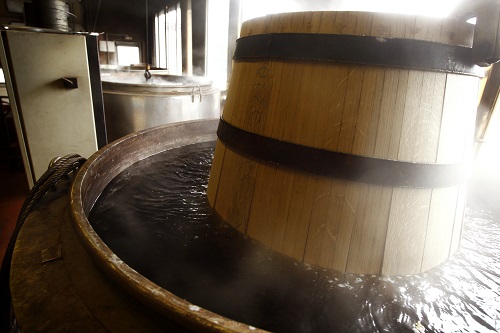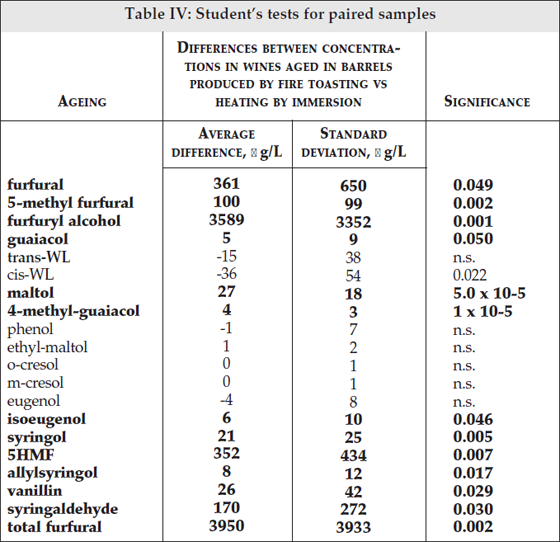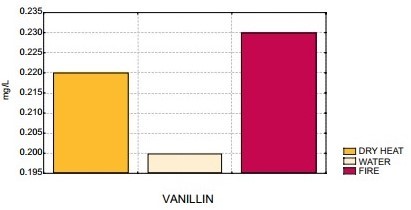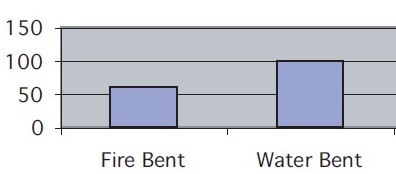
Nope, I’m not talking about a 70s rock band. These are three techniques used by coopers to bend the staves of a wine barrel. The wood staves come in to the cooperage straight. They are heated (by fire, water or steam) to soften the wood fibers and make the staves pliable. Next they’re bent into a bow shape – a centuries-old design for optimal stability and mobility.
Each of these methods has its benefits and changes the flavors and aromas the barrel imparts on the wine. Unfortunately it’s hard to find empirical data that shows the differences between them. Perhaps because it’s hard to isolate the variables – it is rare, and possibly non-existent, for one cooper to offer all three options to its customers.
It was even challenging to find studies comparing just fire bent to water bent. I did find three, all of which were conducted between 1999 and 2004 using wines aged in French or American oak. Two of the three studies included both sensory analysis (people’s perceptions) and chemical analysis (tested in a lab). For this article, I am only focusing on the chemical analysis.
Water bending involves soaking the unbent barrel in hot water, typically at temperatures just below or at boiling from 10 to 30 minutes (depends on the cooperage) to soften the wood. With fire bending, the staves are usually placed over a fire pot for 10 to 20 minutes to soften the wood. After bending, the barrels are toasted.
I’ve always been taught that the primary benefit of bending by water is that it removes some of the harsher tannins from the wood. My non-scientific observation (i.e. tasting) is that it also tends to highlight the fruit and build weight in the mid-palate, but I have no data to back that up.
In the Wines and Vines October 2011 issue, Franck Renaudin from Tonellerie Quintessance says, in reference to the cooperage’s “Hydro-Dynamique” barrels (water bent), “Our method is designed to reduce the oak tannin and prepare the oak for toasting in a way that will result in a softer mouthfeel. Tannin is very soluble in water.” He says the cooperage will only be using the technique on French oak because it has 10 times more tannin content than American oak.
The first study I found comparing fire to water techniques was published in the Practical Winery & Vineyard Journal, November/December 2010 issue, “Chemical and Sensory Profile of Barrels Heated by Immersion [in water] Prior to Bending.” The most significant difference between the water and fire bent barrels was that the concentration of toasting-related compounds (furfural, guaiacol, vanillin, etc.) was much greater in the wine with the fire bent barrels (see table below).
The Journal offers a possible explanation: “The evaporation of additional water [in the immersion barrels] decreases the quantity of calories transmitted to wood during toasting. This ‘loss of energy’ reduces the degree of degradation of wood hemicelluloses and lignin and the production of furan and pyron compounds and aromatic aldehydes and volatile phenols.” Good theory, but the other two studies I found don’t support this finding for compounds other than vanillin.
Perhaps the barrels were soaked for a longer period of time by this cooperage (Siguin Moreau) and therefore had more water in the staves. Or, I noticed the water temperature used by SM was lower than that of at least one of the cooperages in the other studies (the other cooperage did not reveal water temperature). Could this make a difference? Or maybe the wine was aged in barrel for longer/shorter than the other studies (I did not have enough data to compare).

Above: Positive values indicate that concentrations of chemical compounds were higher following bending by fire. Negative values indicate that concentrations were higher following bending by water (immersion).
Another interesting result in the Journal’s study was that the oak lactones, both cis and trans, were higher with the water bent barrels than the fire bent. One of the other studies I will be mentioning (World Cooperage) supports this finding for trans lactones but not for cis (cis is higher in the fire bent), and the third study also does not support this finding (cis is higher in the fire bent, no trans shown). I’d call this inconclusive.
The second study I found was by World Cooperage published in 1999, “Differences in Fire Bent, Dry Heat Tunnel Bent and Water Bent Barrels. The Effect of the Bending Process on Wine Flavor.” There was an interesting quote in the conclusion of this study: “[In fire bent barrels] the hot wood breaks down oak tannins at a far greater rate than those in water bent staves.” If that’s true, then why do cooperages that produce water bent barrels say the main reason they use the technique is to reduce tannins?
World Cooperage was the only study that showed tannin measurement (as ellagic acid, which is released during ellagic tannin hydrolysis), and oddly, the levels of ellagic acid were higher with the fire bent barrels than the water bent. So what does that mean?
If it’s true that fire bending leads to a greater rate of tannin breakdown during toasting, could fire bent barrel samples still end up with higher levels of tannins? According to this study, yes. Perhaps the amount of tannin removed during the hot water soak is so great that it surpasses the tannin loss in the fire bent barrels during toasting. Or maybe this was just an inconsistency in the study.
The third study I found was in the Australian & New Zealand Grapegrower & Winemaker publication, July 2004 issue, “Bending Regime Influences Oak Component Extraction,” by Edward Schulz of Barrel Associates International. He says that the higher moisture content in water bent barrels allows toasting to occur at higher temperatures without charring than with the fire bent barrels. His explanation: water conducts heat better than air. The other two studies do not address this point.
One chemical compound that had clear and consistent results in all three studies was vanillin. For all, vanillin levels were higher in the fire bent barrels than the water bent. Maybe this supports Practical Winery & Vineyard’s theory that excess moisture leads to less degradation/production of oak compounds affected by toasting.

World Cooperage. Pinot Noir matured in French oak (1997 Rodney Strong Pinot Noir, toast level: medium).
As for steam bent barrels, I haven’t found any published trials, but the theory is that steam bending helps to remove harsh tannins, similar to water bending. In addition, the process opens the wood pores which allows for a deeper penetration of toast. Amy Lee of Tonnellerie Berthomieu-Ermitage says she’s seen cross sections of staves that show the darker color of the toast deeper in the staves than with fire bent wood. That makes sense to me. Of course, what effect that has on the flavor of the wine is more subjective.
Amy also says the steam bending allows the cooperage to offer a lighter toasting option, which tends to show more spice and retain tannin (higher heat degrades more tannin). She explains that with steam bending (and similarly with water bending), you start with a blank slate (no toast), whereas with fire bending, you’ve already started the toasting process by bending over a flame so it’s difficult to do a very light toast. With the steam or water bending techniques, you can.
Here is a list of cooperages I know of that offer either water or steam bent barrels. My list might not include all the cooperages that make these types of barrels, and in most cases, the water or steam bent barrels are just one option the cooperage offers, not the only option:
Steam Bent
Bel Air
Ermitage-Berthomieu (only steam bent)
Marchive
Vicard
Water Bent:
Dargaud & Jaegle (only water bent)
Mercier
Saury (provided above photo)
Seguin Moreau
T.W. Boswell
Toneleria Nacional (water-steam combo)
After scouring through this research, there’s one thing I can say with certainty: we need more data! And…there was a rock band in the 70s that sounded like a trio of bending techniques.
